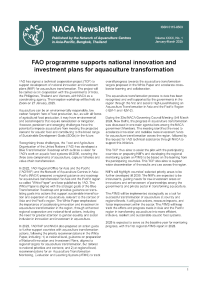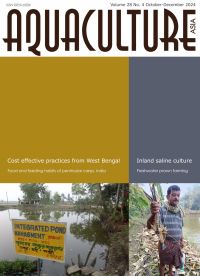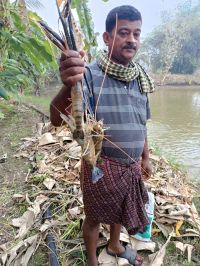With the implementation of the new aquatic animal disease reporting in the Asia Pacific region from January 2021 NACA is publishing reported aquatic animal diseases submitted by countries in the Asia-Pacific region. This report covers the third quarter of 2024 and the original and updated reports can be accessed from the QAAD page.
In this issue:
- FAO programme supports national innovation and investment plans for aquaculture transformation.
- 14th Asian Fisheries Forum, 12-15 February 2025 register now!
- Saudi International Marine Exhibition (SIMEC) 3-5 February 2025, Riyadh.
- Workshop on Sustainable Brine Shrimp Artemia Cultivation, 17 February, Tashkent.
- Status, technological innovations, and industry development needs of mud crab (Scylla spp.) aquaculture.
- Global Seaweed: New and Emerging Markets Report 2023.
In this issue:
- Some practices and techniques in cost-effective small and medium-scale aquaculture in West Bengal
- Food and feeding habits of some peninsular carps
- Inland saline aquaculture: Prospects and challenges
- A success story of freshwater prawn farming as an alternative livelihood for self-help and user groups in Mayurbanja District, Odisha, India
- NACA Newsletter
Freshwater prawn farming has emerged as a viable alternative livelihood for rural communities in Mayurbanja District, Odisha, under the Odisha Integrated Irrigation Project for Climate Resilient Agriculture (OIIPCRA). This World Bank-assisted initiative has supported tribal self-help groups and user groups in adopting aquaculture as a sustainable income source. Through capacity-building programs, exposure visits, and technical support, beneficiaries have successfully engaged in fish and prawn farming, enhancing food security and financial stability. The study evaluates the impact of freshwater prawn farming in two Minor Irrigation Projects (MIPs) in Karanjia and Shyamakhunta blocks, where genetically improved fish and Macrobrachium rosenbergii (scampi) were introduced. Despite challenges such as erratic weather and fluctuating water conditions, both sites demonstrated promising survival and growth rates, with MIP2 yielding superior production due to favorable water availability and market proximity. Economic analysis confirmed the feasibility and profitability of integrating freshwater prawn farming with modern aquaculture techniques.
Salinity is a growing global challenge, affecting soil productivity, freshwater availability, and aquatic ecosystems. Inland saline aquaculture presents a sustainable opportunity to utilise salt-affected water resources for food production. This article examines the prospects and challenges of aquaculture in inland saline environments, focusing on soil and water characteristics, species tolerance, and mitigation strategies. It highlights the potential of using brackish groundwater for aquaculture, reducing pressure on freshwater supplies while making use of degraded lands. The study also discusses the physiological adaptations of fish to salinity stress, the role of key ions in aquaculture success, and the integration of saline aquaculture with traditional farming systems. Inland saline aquaculture could play a critical role in enhancing food security, optimising water resource use, and mitigating environmental degradation in semi-arid and arid regions.



